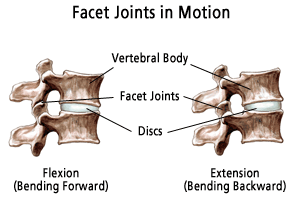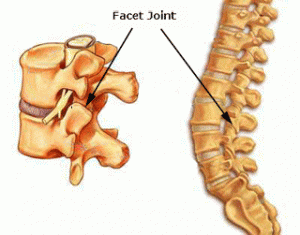Movement in the spine comes from the facet joints.
At the back of each of our vertebrae are four bony projections that form the facet joints that connect each vertebra.
There are two sets of facet joints at the bottom and top of each vertebra on either side of the spinous process.
The connection of the vertebrae through the facet joints both provides stability in the spine and allows for its movement.
The facet joints are synovial joints, which means that they, like many movable joints in the body, are encased in a capsule of fluid, enabling the bones to glide smoothly over one another.
The facet joints allow the spine to flex (forward bending), extend (backward bending), laterally flex (side bending), and rotate (twisting), and any inhibition of movement in the spine is because the facet joints won’t allow it.
One of the early instructions that became ingrained in my brain when I was learning to teach yoga was— the spine needs to extend before it twists.
And I still say it in almost every twist I teach. This extension gives space to the facet joints so they have room to rotate. Take this out of the yoga room and think of all the times you twist in a day. Twisting without extension will add up negatively for the facet joints, and if you add weak or imbalanced muscle tone, the risk of trouble rises.
Poor posture and movement patterns are responsible for an overwhelming number of back issues and related pain. Everyone leans backwards when they stand and walk. It is the mantra of my work.
Muscle tone and balance have a big effect on the facet joints. If everyone leans backwards habitually, their back muscles will likely be short, and the muscles at the front of the body will likely be too long, which puts additional pressure on the facet joints. Figuring out how to lengthen the back while shortening the front is essential to spinal health.
If you buy into the concept that everyone leans backward, then you will also agree that anyone with a tendency to do so is putting undo pressure on the back of the spine.
I know that it is simplifying the issue, but “stop leaning backward” is the answer to so many of life’s painful problems. Your facet joints will be happy if you do.




